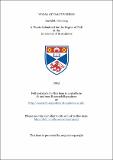Files in this item
Vocal attractiveness
Item metadata
| dc.contributor.author | Feinberg, David R. | |
| dc.coverage.spatial | 291 p. | en_US |
| dc.date.accessioned | 2018-06-19T12:42:39Z | |
| dc.date.available | 2018-06-19T12:42:39Z | |
| dc.date.issued | 2005 | |
| dc.identifier.uri | https://hdl.handle.net/10023/14253 | |
| dc.description.abstract | In this thesis, I aimed to explore vocal attractiveness from an evolutionary perspective: how listener's preferences for vocal qualities of potential partners could increase mating success and reproductive success. Chapters 1-4 outline the background to the thesis, reviews acoustics, sexual selection theory, and human mate-choice. In chapter 5, I correlated attributions made to voices to the acoustic properties of the voices. In men's voices, pitch negatively predicted vocal attractiveness. Attributions of masculinity, size, age, health and vocal attractiveness were all positively correlated. In women's voices, pitch, formant dispersion and perceived health positively predicted vocal attractiveness. Masculinity, size and age negatively predicted vocal attractiveness. In chapter 6, I measured the effect of manipulating fundamental and/or formant frequencies (apparent vocal-tract length) on vocal attributions. Women found men's voices with lowered voice pitch and decreased formant dispersion more attractive, masculine, large, older and healthier. Women's size predicted preference for male vocal- tract length. In chapter 7, I explored attitudes to voices speaking vowels and whole sentences using a correlation design and acoustic manipulations. Women's self-rated attractiveness positively predicted vocal masculinity preferences. Most of the remaining studies focus on how hormones relate to vocal production and perception. Women with less oestrogen showed the biggest menstrual cycle shifts in vocal masculinity preferences, preferring masculinity most in the fertile phase (chapter 8). Men's testosterone levels predicted the size of changes in attributions of dominance to men's voices (chapter 9). Women's voice pitch correlated with facial-metric masculinity and facial attractiveness (chapter 10). Men preferred women's voices with raised pitch to lowered pitch at multiple levels of starting pitch (chapter 11). These findings indicate men preferred femininity to averageness. In chapter 12, I relate the work in this thesis to other work and the broader evolutionary perspective. | en_US |
| dc.language.iso | en | en_US |
| dc.publisher | University of St Andrews | |
| dc.subject.lcc | HM1151.5F4 | |
| dc.subject.lcsh | Voice--Psychological aspects | en |
| dc.subject.lcsh | Sexual attraction | en |
| dc.subject.lcsh | Mate selection | en |
| dc.subject.lcsh | Voice--Physiology | en |
| dc.title | Vocal attractiveness | en_US |
| dc.type | Thesis | en_US |
| dc.type.qualificationlevel | Doctoral | en_US |
| dc.type.qualificationname | PhD Doctor of Philosophy | en_US |
| dc.publisher.institution | The University of St Andrews | en_US |
This item appears in the following Collection(s)
Items in the St Andrews Research Repository are protected by copyright, with all rights reserved, unless otherwise indicated.

